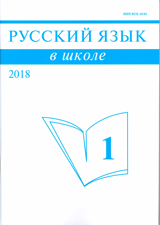
Russian Language at School is a peer-reviewed research journal founded in 1914. The Journal encourages discussions around topical issues of teaching and studying the Russian language, presents the results of fundamental and applied research in the field of Russian studies and methods of teaching the Russian language. For over 100 years of its existence, the Journal has accumulated a large amount of information on the history and current state of the Russian language, its grammar, vocabulary, phraseology, stylistics and spelling. The Journal aims to present significant achievements of Russian and foreign linguistic and methodological schools.
The Editorial Board and the Editorial Council features distinguished scholars in the field of Russian studies. Among the authors are leading experts in the field of the Russian language and the methodology of its teaching at the school and university level. The Journal is addressed to researchers, practitioners and graduate students specialising in the field of philology. The Editorial Board and the Editorial Council make every effort to maintain and develop the scientific and methodological potential of the Journal.
Russian Language at School is included in the Higher Attestation Commission (VAK) List of Leading Peer-reviewed Scientific Journals, in which the main scientific results of dissertations for doctoral and candidate of science degrees are published.
List of specialist subjects covered by the Journal:
5.8.2. Theory and methods of teaching and upbringing (by areas and levels of education) (Pedagogical sciences),
5.9.5. Russian language. Languages of the peoples of Russia (Philological sciences),
5.9.8. Theoretical, applied and comparative linguistics (Philological sciences)
(https://vak.minobrnauki.gov.ru/main).
Periodicity: 6 times per year (3 issues per six months).
The Journal publishes research articles reporting original theoretical and practical studies, review articles, book reviews, as well as short communications describing significant scientific events. The application Russian at School and at Home is intended for practicing teachers.
The Journal considers only original manuscripts that have not been previously published and are not are under consideration for publication anywhere else. Any forms of plagiarism, including self-plagiarism, is prohibited.
The Journal has an international status, which is confirmed by the composition of the Editorial Board and the Editorial Council (Russia, Belarus, Finland, Austria, Poland, Hungary, Germany, China).
Electronic versions of the issues are distributed by subscription and uploaded on the Journal's website, on the Scientific Electronic Library and on the websites of partners. A subscription to the printed version of the Journal can be taken out at Russian post offices.
You can subscribe to the printed version of the journal through our partners:
- IVIS (to subscribe to the printed version of the journal submit a request to periodicals@ivis.ru or periodicals@eastview.com with your delivery address details).
- SPA / Scientific Productive Association "INFORM-SYSTEMA" (to subscribe to the printed version of the journal submit a request to info@informsystema.ru with your delivery address details).
Our partners send an invoice to a customer and provide the specified bank details for the customer to pay for the order. The partners order journal issues from the editorial office and post them to the address given by the customer.
You can also subscribe to the electronic version of the journal:
1) Via the website of the National electronic library: https://elibrary.ru/
2) Via the subscription agency "IVIS": http://www.ivis.ru/
3) On the RUCONT platform: https://rucont.ru/
4) Via the EastViewShop website: https://shop.eastview.com/results/item?sku=980829PO
5) Via the website of the journal "Russian language at school": https://www.riash.ru/jour/user/subscriptions
The journal is registered by the Federal Service for Supervision of Communications, Information Technologies and Mass Communications (certificate PI No. FS77-80108 dated December 31, 2020).
ISSN 0131-6141 (Print) 2619-0966 (Online)
Current issue
METHODOLOGY AND EXPERIENCE
RUSSIAN LANGUAGE ABROAD
LITERARY TEXT ANALYSIS
LINGUISTIC NOTES
LANGUAGE AND CULTURE
RUSSIAN LANGUAGE IN INSTITUTIONS OF HIGHER EDUCATION
LINGUISTIC HERITAGE
CRITICISM AND BIBLIOGRAPHY
CHRONICLE
Announcements
2025-05-29
Всероссийская научно-методическая конференция «Актуальные вопросы изучения языка и литературы в школе и в вузе» («Лебедевские чтения»)
21 и 22 ноября 2025 года состоится Всероссийская научно-методическая конференция «Актуальные вопросы изучения языка и литературы в школе и в вузе» («Лебедевские чтения»), посвященная памяти известного специалиста по методике преподавания русского языка в русской и национальной школе – Алексея Матвеевича Лебедева, основателя старейшего российского научно-методического журнала «Родной язык в школе».
Направления конференции:
- Актуальные вопросы современной теории и технологии преподавания языка в вузе и школе.
- Актуальные вопросы преподавания литературы в школе.
- Современные подходы к работе с текстом на уроках языка, литературы и развития речи.
- Формирование языковой и культурологической компетенций современной языковой личности.
- Проблемы социокультурной внеаудиторной работы учителя-словесника.
- Преподавание языка и литературы в поликультурной среде.
- Вопросы преподавания курса «Русский родной язык» в современной школе.
К участию в конференции приглашаются ученые-лингвисты, преподаватели гуманитарных дисциплин вузов, специалисты по методике преподавания русского языка и литературы, учителя-словесники российских школ; студенты и магистранты гуманитарных факультетов вузов.
Все зарегистрированные участники конференции получат сертификаты участников.
Материалы конференции (статьи) после отбора оргкомитетом будут изданы отдельным сборником, с размещением электронной версии в базе данных РИНЦ. Оргкомитет осуществляет отбор рукописей для публикации.
Заявку на участие в конференции и текст статьи (по материалу доклада) необходимо прислать до 1 ноября на электронный адрес: antonova_lubov@mail.ru (Антонова Любовь Геннадьевна).
| More Announcements... |




































